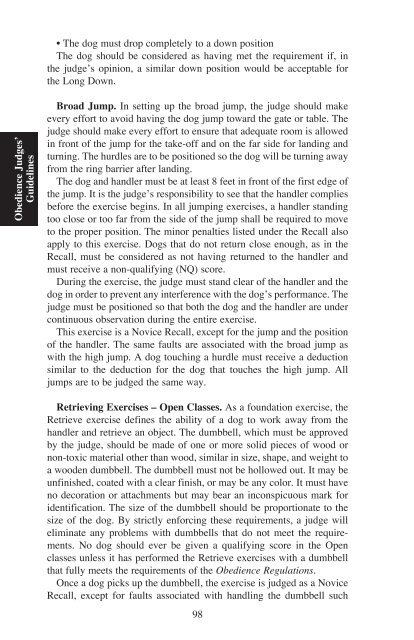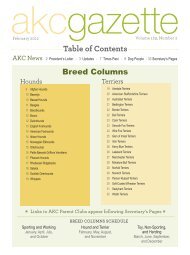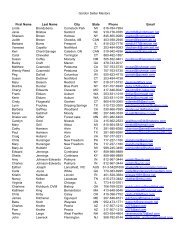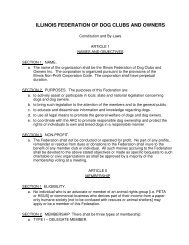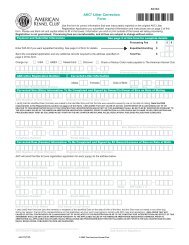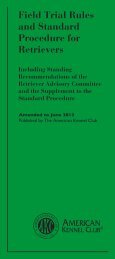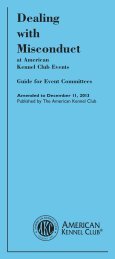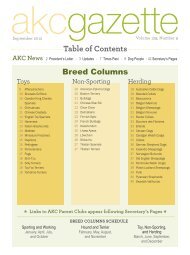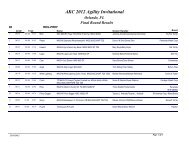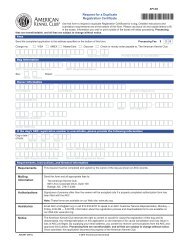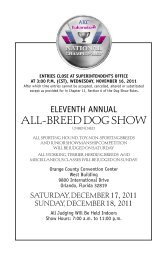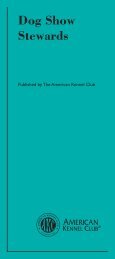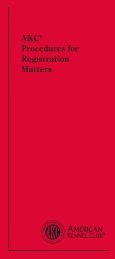Obedience Regulations - American Kennel Club
Obedience Regulations - American Kennel Club
Obedience Regulations - American Kennel Club
Create successful ePaper yourself
Turn your PDF publications into a flip-book with our unique Google optimized e-Paper software.
<strong>Obedience</strong> Judges’<br />
Guidelines<br />
• The dog must drop completely to a down position<br />
the dog should be considered as having met the requirement if, in<br />
the judge’s opinion, a similar down position would be acceptable for<br />
the long Down.<br />
Broad Jump. in setting up the broad jump, the judge should make<br />
every effort to avoid having the dog jump toward the gate or table. the<br />
judge should make every effort to ensure that adequate room is allowed<br />
in front of the jump for the take-off and on the far side for landing and<br />
turning. the hurdles are to be positioned so the dog will be turning away<br />
from the ring barrier after landing.<br />
the dog and handler must be at least 8 feet in front of the first edge of<br />
the jump. it is the judge’s responsibility to see that the handler complies<br />
before the exercise begins. in all jumping exercises, a handler standing<br />
too close or too far from the side of the jump shall be required to move<br />
to the proper position. the minor penalties listed under the recall also<br />
apply to this exercise. Dogs that do not return close enough, as in the<br />
recall, must be considered as not having returned to the handler and<br />
must receive a non-qualifying (nQ) score.<br />
During the exercise, the judge must stand clear of the handler and the<br />
dog in order to prevent any interference with the dog’s performance. the<br />
judge must be positioned so that both the dog and the handler are under<br />
continuous observation during the entire exercise.<br />
this exercise is a novice recall, except for the jump and the position<br />
of the handler. the same faults are associated with the broad jump as<br />
with the high jump. A dog touching a hurdle must receive a deduction<br />
similar to the deduction for the dog that touches the high jump. All<br />
jumps are to be judged the same way.<br />
Retrieving Exercises – Open Classes. As a foundation exercise, the<br />
retrieve exercise defines the ability of a dog to work away from the<br />
handler and retrieve an object. the dumbbell, which must be approved<br />
by the judge, should be made of one or more solid pieces of wood or<br />
non-toxic material other than wood, similar in size, shape, and weight to<br />
a wooden dumbbell. the dumbbell must not be hollowed out. it may be<br />
unfinished, coated with a clear finish, or may be any color. it must have<br />
no decoration or attachments but may bear an inconspicuous mark for<br />
identification. the size of the dumbbell should be proportionate to the<br />
size of the dog. by strictly enforcing these requirements, a judge will<br />
eliminate any problems with dumbbells that do not meet the requirements.<br />
no dog should ever be given a qualifying score in the open<br />
classes unless it has performed the retrieve exercises with a dumbbell<br />
that fully meets the requirements of the <strong>Obedience</strong> <strong>Regulations</strong>.<br />
once a dog picks up the dumbbell, the exercise is judged as a novice<br />
recall, except for faults associated with handling the dumbbell such<br />
98


